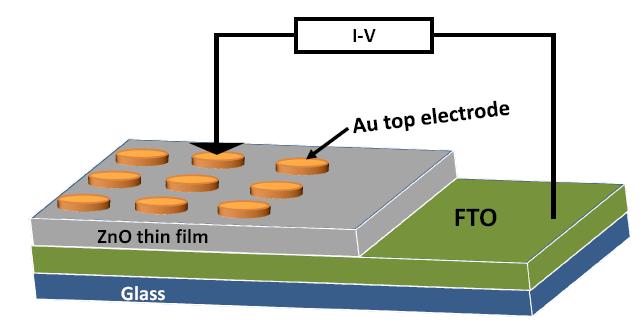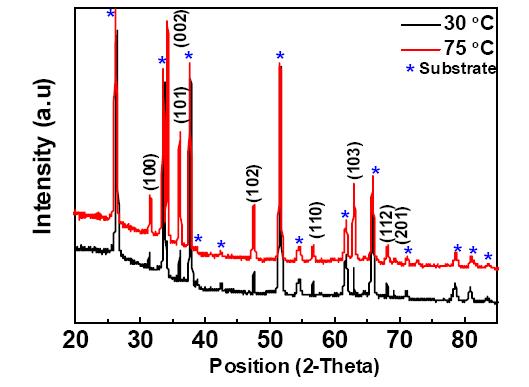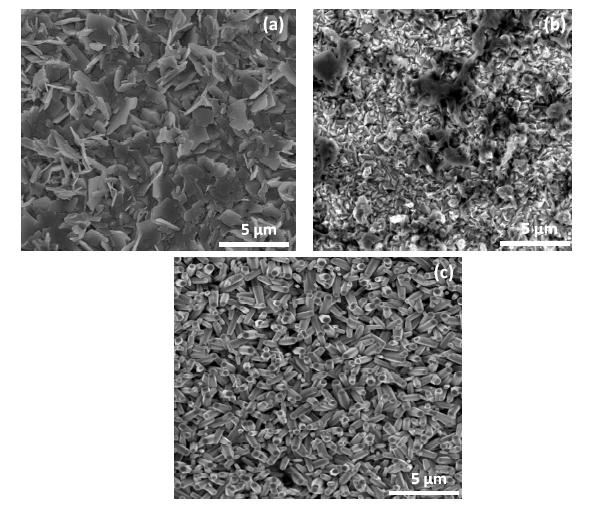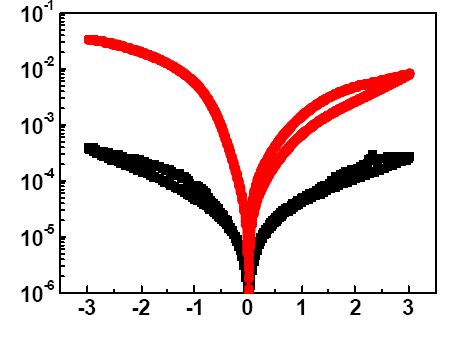Citation: Shuhan Jing, Adnan Younis, Dewei Chu, Sean Li. Resistive Switching Characteristics in Electrochemically Synthesized ZnO Films[J]. AIMS Materials Science, 2015, 2(2): 28-36. doi: 10.3934/matersci.2015.2.28
| [1] | Nur Jassriatul Aida binti Jamaludin, Shanmugan Subramani . Thermal performance of LED fixed on CVD processed ZnO thin film on Al substrates at various O2 gas flow rates. AIMS Materials Science, 2018, 5(2): 246-256. doi: 10.3934/matersci.2018.2.246 |
| [2] | Nur Jassriatul Aida binti Jamaludin, Shanmugan Subramani, Mutharasu Devarajan . Thermal and optical performance of chemical vapor deposited zinc oxide thin film as thermal interface material for high power LED. AIMS Materials Science, 2018, 5(3): 402-413. doi: 10.3934/matersci.2018.3.402 |
| [3] | Muhamed Shajudheen V P, Saravana Kumar S, Senthil Kumar V, Uma Maheswari A, Sivakumar M, Sreedevi R Mohan . Enhancement of anticorrosion properties of stainless steel 304L using nanostructured ZnO thin films. AIMS Materials Science, 2018, 5(5): 932-944. doi: 10.3934/matersci.2018.5.932 |
| [4] | Haridas D. Dhaygude, Surendra K. Shinde, Ninad B. Velhal, G.M. Lohar, Vijay J. Fulari . Synthesis and characterization of ZnO thin film by low cost modified SILAR technique. AIMS Materials Science, 2016, 3(2): 349-356. doi: 10.3934/matersci.2016.2.349 |
| [5] | Haiqing Yao, Fei Li, Jodie Lutkenhaus, Masaya Kotaki, Hung-Jue Sue . High-performance photocatalyst based on nanosized ZnO-reduced graphene oxide hybrid for removal of Rhodamine B under visible light irradiation. AIMS Materials Science, 2016, 3(4): 1410-1425. doi: 10.3934/matersci.2016.4.1410 |
| [6] | Chaitra Srikanth, Gattumane Motappa Madhu, Hemanth Bhamidipati, Siddarth Srinivas . The effect of CdO–ZnO nanoparticles addition on structural, electrical and mechanical properties of PVA films. AIMS Materials Science, 2019, 6(6): 1107-1123. doi: 10.3934/matersci.2019.6.1107 |
| [7] | Sironmani Palraj, Muthaiah Selvaraj, Sundarajan Muthukrishnan . Effect of pretreatments on electrodeposited epoxy coatings for electronic industries. AIMS Materials Science, 2016, 3(1): 214-230. doi: 10.3934/matersci.2016.1.214 |
| [8] | Iryna Markevich, Tetyana Stara, Larysa Khomenkova, Volodymyr Kushnirenko, Lyudmyla Borkovska . Photoluminescence engineering in polycrystalline ZnO and ZnO-based compounds. AIMS Materials Science, 2016, 3(2): 508-524. doi: 10.3934/matersci.2016.2.508 |
| [9] | Jens Bürger, Alireza Goudarzi, Darko Stefanovic, Christof Teuscher . Computational capacity and energy consumption of complex resistive switch networks. AIMS Materials Science, 2015, 2(4): 530-545. doi: 10.3934/matersci.2015.4.530 |
| [10] | Clotaire Chevalier-César, Martine Capochichi-Gnambodoe, Fang Lin, Dapeng Yu, Yamin Leprince-Wang . Effect of growth time and annealing on the structural defect concentration of hydrothermally grown ZnO nanowires. AIMS Materials Science, 2016, 3(2): 562-572. doi: 10.3934/matersci.2016.2.562 |
Resistive random access memory (ReRAM) has been regarded as next generation nonvolatile memory due to its simple structure and compatibility with complementary metal oxide semiconductor technology [1,2,3,4,5]. Contrary to traditional flash memories, ReRAM offer some unique advantages of faster writing rate, smaller bit size, and lower operating voltages. More importantly, by imposing electric pulses the transition in resistive states can be achieved within tenths of nanoseconds at room temperature and the resultant resistance states can be retained for 10 years [2,6,7].
A typical configuration of the ReRAM device usually consists of metal/insulator/metal sandwich like structure and its operation is based on switching of resistance states from high to low or vice versa by putting voltage stimuli. To date, variety of materials has been exploited for resistive switching characteristics. Among them all, binary transition metal oxide (TiO2, NiO, ZnO, and Cu2O) [1,2,4,6,8,9,10,11] attracted increasing interests in material choice due to controllable compositions. Generally, the switching behaviours can be classified into (1) unipolar and (2) bipolar switching. The unipolar resistive switching (RS) is independent of bias polarity and strongly dependent on strength of input voltage signal. While, bipolar switching shows a directional RS depending on the polarity of the applied voltage [12].
Zinc oxide (ZnO) has been widely well known material for its excellent optical, electronics and sensing applications. In recent past, it has also been exploited as resistive switching material too [13,14]. In this manuscript, we deployed a state of the art electrochemical deposition route to synthesize ZnO thin films. Electrodeposition is an effective way to fabricate high quality metal oxide thin films, at low temperature and ambient atmosphere. Moreover, in this process, the deposition of metal oxide layers on the substrate is driven by the external electric field. Therefore, it is facile to precisely control the layer microstructures by this method and further to design heterostructures with novel functionalities. Herein, the effect of deposition temperature on crystal structure, surface morphology and specifically resistive switching characteristics was investigated. It was found that crystallinity and surface morphologies can be well tuned by adjusting the deposition temperature. Furthermore, the samples prepared at higher temperatures demonstrated excellent resistive switching performances. To explain RS behaviour in these films, a conduction model based on conducting filaments was proposed whose formation/rupture is attributed to change the device resistive states.
Electrodeposition of ZnO was carried out using an Autolab 302N electrochemical workstation. A standard three-electrode setup in an undivided cell was used. Fluorine doped Tin oxide (FTO) (9.3-9.7 Ω, Asashi Glass Corporation, Japan, 1.1 mm × 26 mm × 30 mm) was used as the working electrode, while platinum foil (0.2 mm × 10 mm × 20 mm) was used as the counter electrode. The distance between the two electrodes was 30 mm. The reference electrode was an Ag/AgCl electrode in 4 M KCl solution, against which all the potentials reported herein were measured.
The FTO substrates were first cleaned by ethanol and acetone followed by treated by sonication/ultra-violet ozone. The electrodeposition was carried out in a solution of 0.01 M Zn(NO3)2∙6H2O at 1 mA for 20 min, at 30, 50 and 75 °C. The phase composition of the samples was characterized by X-ray diffraction (Philips X’pert Multipurpose X-ray Diffraction System (MRD) with Cu Kα). The surface morphologies of the samples were observed by scanning electron microscopy (SEM, Nova 230). To measure the electrical properties of the prepared nanocomposite films, Au top electrodes (250 μm diameter) were patterned and deposited by sputtering using a metal shadow mask. Voltage-current curves of the films were measured using an Autolab 302N electrochemical workstation controlled with Nova software. During measurement, the working electrode and sensor electrode were connected to the top Au electrode, while the reference and counter electrode were connected to the FTO substrate. A schematic of the I-V measurement setup is shown in Figure 1.
 Figure 1. Setup for the current-voltage measurements of ZnO thin films using an electrochemical workstation.
Figure 1. Setup for the current-voltage measurements of ZnO thin films using an electrochemical workstation.
The electrochemical synthesis of ZnO is a four step process: First, nitrate ions and H2O are electrochemically reduced at the surface of the working electrode, resulting in an increase in local pH value in the vicinity of the reference electrode (equation (1), (2)); Then, the increase in the local pH leads to the precipitation of zinc ions as zinc hydroxide (Zn(OH)2, equation (3)) at suitable temperature and Zn(OH)2 can be transformed into ZnO.
| NO3- + H2O + 2e- → NO2- + 2OH- | (1)—0.20 V vs. Ag/AgCl |
| 2H2O + 2e- → H2 + 2OH- | (2)—1.05 V vs. Ag/AgCl |
| Zn2+ + 2OH- → Zn(OH)2 | (3) |
| Zn(OH)2 → ZnO + H2O | (4) |
The X-ray diffraction pattern of ZnO thin films synthesized on FTO substrate at 30 and 75 °C is shown in figure 2. All diffraction peaks are consistent with the FTO and ZnO wurtzite structure, which can be indexed to a standard spectrum of JCPDS (No. 36-1451). In the XRD patterns, the (002) peak of sample prepared at 75 °C is dominant, and its intensity is much higher than that of the other peaks and of sample prepared at 20 °C. This also points towards its preferential growth in [001] orientation along c-axis and improved crystallinity over the sample prepared at low temperatures.
 Figure 2. XRD patterns of ZnO thin films at 30 °C and 75 °C on FTO substrate.
Figure 2. XRD patterns of ZnO thin films at 30 °C and 75 °C on FTO substrate.The SEM images of ZnO thin films prepared at 30, 50 and 75 °C can be depicted in Figure 3. It can be clearly observed that by increasing deposition temperature, the surface morphology of ZnO films was transformed from nano flakes (figure 3a) to agglomerated nanoparticles (figure 3b) and then to nanorods arrays (figure 3c). These nanorods are well-crystalline and their average diameter is measured as about 250 nm. Usually, ZnO grows preferentially along [001] direction in aqueous solution due to lowest surface energy of (001) facet. And the growth velocity along [010] directions is slower than that of [001] direction, resulting in nanorod morphology.
 Figure 3. Scanning electron microscopy of ZnO thin films synthesized at (a) 30 °C (b) 50 °C and (c) 75 °C.
Figure 3. Scanning electron microscopy of ZnO thin films synthesized at (a) 30 °C (b) 50 °C and (c) 75 °C.The typical current-voltage curves of ZnO thin films synthesized at various temperatures are shown in figure 4. To carrying out such measurements, the dc voltage sweep mode was utilized in the sequence of 0 à −3 à 0 à +3à 0 V, at a scan rate of 0.01 V/s. During the measurements, the bias voltage was applied on the top electrode (TE) with bottom electrode (BE) as grounded, and neither a forming process nor a current compliance was necessary for activating the memory effort. It is interesting to note that samples prepared at low temperatures (30 and 50 °C) didn’t show any considerable resistive switching phenomenon as shown in figure 4. For the ZnO thin films prepared at 75 °C (ZnO nanorods), a jump in resistance state from high resistance to low resistance state at about −2.2V which is referred as the set process. Subsequently, a reset process (~2.5 V) was also observed by sweeping the voltage in positive direction. It is noteworthy to mention that our devices (ZnO nanorods) exhibit typical bipolar resistive switching, that is, the cell can only be written with a negative bias and erased with a positive one which was verified by numerous measurements.
 Figure 4. Typical current-voltage curves of ZnO thin films prepared at various temperatures in semi-logarithmic scale.
Figure 4. Typical current-voltage curves of ZnO thin films prepared at various temperatures in semi-logarithmic scale.
The endurance characteristics of the Au/ZnO(nanorods)/FTO memory cell are shown in figure 5. The memory window defined by the two resistance states, i.e., (ROFF − RON)/RON ≈ ROFF/RON. The device successfully demonstrated to distinguish between two resistive states for about 2000 cycles. This memory margin usually utilized to distinguish the storage information between “1” and “0”. The resistance of the HRS scatter in a certain extent during cycling. However, due to long cycle numbers, this kind of scattering may be tolerated. The endurance measurements ensured that the switching between ON and OFF states is highly controllable, reversible, and reproducible. After the device was switched ON or OFF, no electrical power was needed to maintain the resistance within the given state.
 Figure 5. Data endurance performance of ZnO nanorods based memory device for 2000 cycles.
Figure 5. Data endurance performance of ZnO nanorods based memory device for 2000 cycles.
Subsequently, the data retention test was also carried out in both the OFF and ON states for 1800 seconds at room temperature (as shown in Figure 6). The device successfully retained its both resistance states for about half an hour.
 Figure 6. Data retention performance of the ZnO device for 1800 seconds at room temperature.
Figure 6. Data retention performance of the ZnO device for 1800 seconds at room temperature.
So far, many models have been proposed to explain the resistive switching phenomenon. Among them all, the most widely reported phenomenon is based on formation of conducting filaments during set process and their annihilation during reset process. For ZnO based memory cells, the filamentary mechanism can also be utilized on the basis of current-voltage characteristics [13]. According to filament theory, defects might condense in the metal oxide to form tiny conducting filaments at HRS, and these tiny conducting filaments could gather and align to form long conducting filament, leading to transition to LRS [15]. In this work, conducting filaments in ZnO may be created along or with the walls of individual ZnO nanorod during set process. With applied potential reversely, these filaments can be ruptured easily to transform the device conductance state to its inherent phase. Thus a transition from low resistance state to high resistance state is observed.
In this report, a facile and cost-effective bottom up strategy of electrochemical deposition is deployed to fabricate ZnO thin films at various temperatures. Our findings suggest that samples prepared at 75 °C demonstrated greater crystallinity and well uniform surface morphology of ZnO nanorods than the samples prepared at low temperatures. Furthermore, ZnO samples prepared at 75 °C (ZnO nanorods) expressed superior resistive switching characteristics than other samples prepared at lower temperatures. Also, the ZnO nanorods based memory cells demonstrated a capability to retain its resistance states for 2000 switching cycles. Defects related switching mechanism was also proposed to support the results. The present work demonstrates that ZnO films have the potential for next generation non-volatile memory applications.
This research was sponsored by Australian Research Council (ARC) Discovery Projects of DP140104373, DP150103006.
The author declares no conflicts of interest in this paper.
| [1] |
Liu SQ, Wu NJ, Ignatiev A (2000) Electric-pulse-induced reversible resistance change effect in magnetoresistive films. Appl Phys Lett 76: 2749-2751. doi: 10.1063/1.126464

|
| [2] |
Yang JJ, Pickett MD, Li X, et al. (2008) Memristive switching mechanism for metal//oxide//metal nanodevices. Nat Nano 3: 429-433. doi: 10.1038/nnano.2008.160

|
| [3] | Wu SX, Li XY, Xing XJ, et al. (2009) Resistive dependence of magnetic properties in nonvolatile Ti/Mn:TiO2/SrTi0.993Nb0.007O3/Ti memory device. Appl Phys Lett 94: 253504-253503. |
| [4] |
Beck A, Bednorz JG, Gerber C, et al. (2000) Reproducible switching effect in thin oxide films for memory applications. Appl Phys Lett 77: 139-141. doi: 10.1063/1.126902

|
| [5] |
Chua L (1971) Memristor-The missing circuit element. IEEE Transactions on Circuits Theory 18:507-519. doi: 10.1109/TCT.1971.1083337

|
| [6] |
Seo JW, Park J-W, Lim KS, et al. (2008) Transparent resistive random access memory and its characteristics for nonvolatile resistive switching. Appl Phys Lett 93: 223505-223503. doi: 10.1063/1.3041643

|
| [7] |
Strukov DB, Snider GS, Stewart DR, et al. (2008) The missing memristor found. Nature 453:80-83. doi: 10.1038/nature06932

|
| [8] |
Seo S, Lee MJ, Seo DH, et al. (2004) Reproducible resistance switching in polycrystalline NiO films. Appl Phys Lett 85: 5655-5657. doi: 10.1063/1.1831560

|
| [9] |
Choi BJ, Jeong DS, Kim SK, et al. (2005) Resistive switching mechanism of TiO2 thin films grown by atomic-layer deposition. J Appl Phys 98: 033715-033710. doi: 10.1063/1.2001146

|
| [10] |
Chen A, Haddad S, Wu YC, et al. (2008) Erasing characteristics of Cu2O metal-insulator-metal resistive switching memory. Appl Phys Lett 92: 013503-013503. doi: 10.1063/1.2828864

|
| [11] |
Villafuerte M, Heluani SP, Juarez G, et al. (2007) Electric-pulse-induced reversible resistance in doped zinc oxide thin films. Appl Phys Lett 90: 052105-052103. doi: 10.1063/1.2437688

|
| [12] |
Younis A, Chu D, Li S (2013) Bi-stable resistive switching characteristics in Ti-doped ZnO thin films. Nanoscale Res Lett 8: 1-6. doi: 10.1186/1556-276X-8-1

|
| [13] |
Sun W, Zhang K, Wang F, et al. (2013) Resistive Switching Characteristics of Zinc Oxide Resistive RAM Doped with Nickel. ECS Transactions 52: 1009-1014. doi: 10.1149/05201.1009ecst

|
| [14] |
Peng C-N, Wang C-W, Chan T-C, et al. (2012) Resistive switching of Au/ZnO/Au resistive memory: an in situ observation of conductive bridge formation. Nanoscale Res Lett 7: 559. doi: 10.1186/1556-276X-7-559

|
| [15] |
Chang W (2010) Resistive switching behaviors of ZnO nanorod layers. Appl Phys Lett 96:242109. doi: 10.1063/1.3453450

|
| 1. | Somnath S. Kundale, Akhilesh P. Patil, Snehal L. Patil, Prashant B. Patil, Rajanish K. Kamat, Deok-kee Kim, Tae Geun Kim, Tukaram D. Dongale, Effects of switching layer morphology on resistive switching behavior: A case study of electrochemically synthesized mixed-phase copper oxide memristive devices, 2022, 27, 23529407, 101460, 10.1016/j.apmt.2022.101460 | |
| 2. | Somnath S. Kundale, Girish U. Kamble, Pradnya P. Patil, Snehal L. Patil, Kasturi A. Rokade, Atul C. Khot, Kiran A. Nirmal, Rajanish K. Kamat, Kyeong Heon Kim, Ho-Myoung An, Tukaram D. Dongale, Tae Geun Kim, Review of Electrochemically Synthesized Resistive Switching Devices: Memory Storage, Neuromorphic Computing, and Sensing Applications, 2023, 13, 2079-4991, 1879, 10.3390/nano13121879 | |
| 3. | Pradnya P. Patil, Somnath S. Kundale, Shubham V. Patil, Santosh S. Sutar, Junseong Bae, Sunil J. Kadam, Krantiveer V. More, Prashant B. Patil, Rajanish K. Kamat, Seunghyun Lee, Tukaram D. Dongale, Self‐Assembled Lanthanum Oxide Nanoflakes by Electrodeposition Technique for Resistive Switching Memory and Artificial Synaptic Devices, 2023, 1613-6810, 10.1002/smll.202303862 |